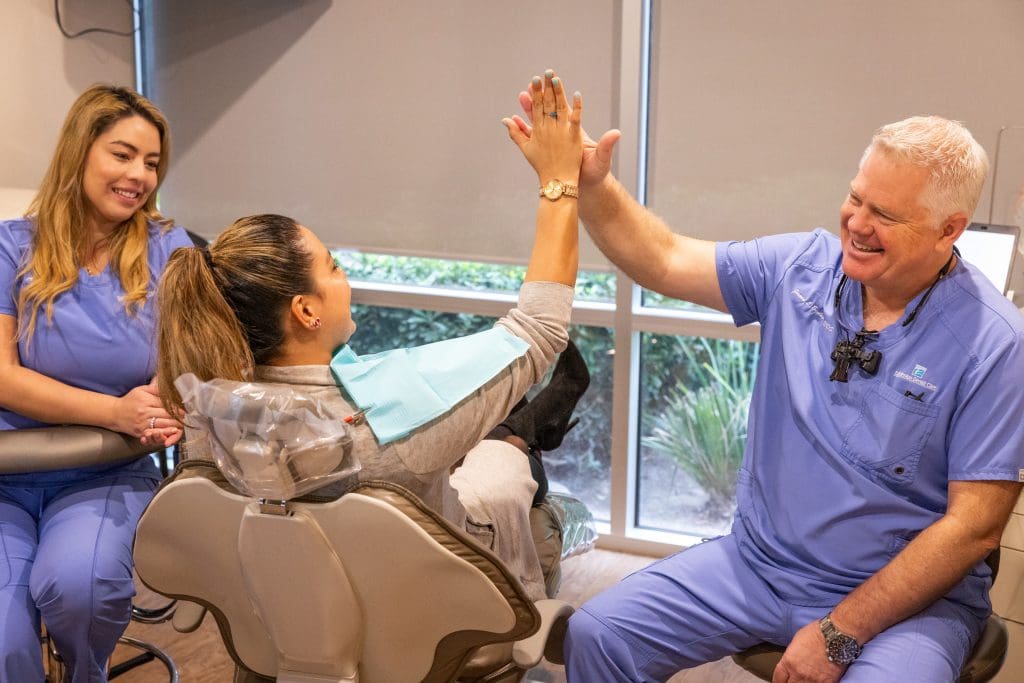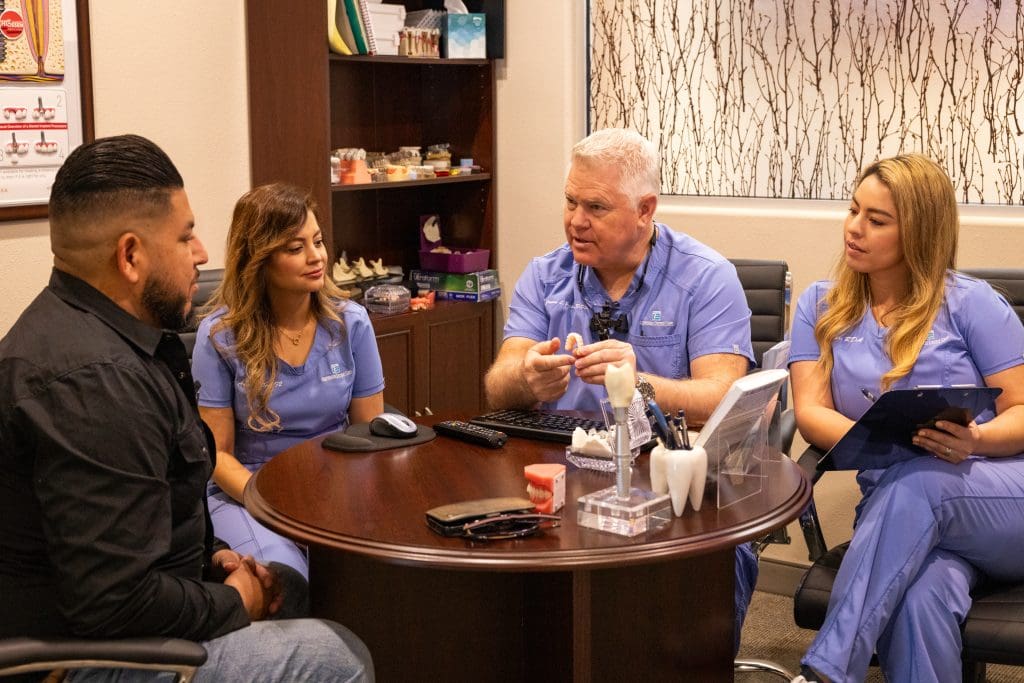Welcome to Eggleston Dental Care, where Dr. Jim Eggleston and his dedicated team provide the best dental care services in Turlock. Our practice takes pride in offering a range of advanced dental treatments, including bone grafting, which is an essential procedure for patients who have lost or damaged bone. This process allows us to restore the structure and function of the jawbone, providing a stable foundation for dental implants and other restorative treatments. To learn more about our full range of dental services, visit Eggleston Dental Care or call us at (209) 634-5871 to schedule your consultation today.
Types of Bone Grafting Procedures
At Eggleston Dental Care, we offer several types of bone grafting procedures tailored to meet each patient’s individual needs. Bone grafting is a specialized procedure that replaces lost or damaged bone in the jaw, a common issue for patients who have suffered from gum disease, trauma, or tooth loss. By restoring the bone, we can improve the structure and function of your jaw, making it possible to receive dental implants and other restorations.
The three main types of bone grafting procedures we offer include autografts, allografts, and xenografts, each with distinct benefits.
Autografts
Autografts are bone grafts harvested from the patient’s own body, typically from areas like the chin, hip, or tibia. Since the bone comes from the patient, autografts are considered the most reliable option for grafting, as there is no risk of immune rejection. The body readily accepts its own tissue, leading to a higher success rate and faster integration into the existing bone structure.
Allografts
Allografts involve using bone from a human donor, usually sourced from a bone bank. This type of graft is thoroughly screened and processed to ensure it is safe for use. Allografts are an excellent option for patients who do not have enough viable bone to harvest from their own body or prefer to avoid a second surgical site. While the success rate is slightly lower than autografts, allografts still offer a reliable solution for bone restoration.
Xenografts
Xenografts use bone harvested from animal sources, commonly bovine (cow) bone. The animal bone is processed to remove any organic components, leaving behind a strong and stable bone material that can integrate with the patient’s jawbone. Xenografts are particularly useful for larger grafts or for patients who prefer not to use human donor tissue. While this option may take slightly longer to integrate with the existing bone, it provides excellent support for dental implants and other restorative procedures.
Benefits of Bone Grafting
Bone grafting is a common procedure with numerous benefits for patients who have suffered from bone loss due to injury, gum disease, or long-term tooth loss. At Eggleston Dental Care, we perform bone grafting to help patients restore both the function and appearance of their smiles. Below are some of the key benefits that make bone grafting an essential part of restorative dental care.
Restoring Jawbone Structure
One of the primary benefits of bone grafting is the restoration of the jawbone’s structure. When teeth are missing for an extended period, the surrounding bone begins to deteriorate due to lack of stimulation. This can lead to a weakened jaw and a sunken-in facial appearance, giving patients an older, more aged look. By grafting new bone to the jaw, we can help restore its shape and strength, preventing further deterioration and supporting a healthier, more youthful appearance.
Supporting Dental Implants
For many patients, bone grafting is an essential step before receiving dental implants. Implants require a strong and stable foundation to anchor the artificial tooth securely in place. If the jawbone is too thin or weak, the implant may fail. Bone grafting provides the necessary support by rebuilding the bone structure, ensuring that the implant will be stable and long-lasting. With a successful graft, patients can enjoy the benefits of dental implants, such as improved chewing ability, speech, and overall oral health.
Preserving Oral Health
Bone loss doesn’t just affect the appearance of your smile; it can also have serious implications for your oral health. When bone loss occurs, it can lead to shifting teeth, misaligned bites, and even further tooth loss. Bone grafting helps to preserve the integrity of your jawbone, preventing these complications and maintaining the alignment and health of your remaining teeth. By taking a proactive approach to bone loss, we can help you avoid more extensive treatments down the road.
Preparation for Bone Grafting
Before undergoing a bone grafting procedure, it is essential to understand the preparation process. At your initial consultation, our dentists will thoroughly evaluate your oral health to determine if bone grafting is the right option for you. This evaluation typically includes X-rays and 3D scans to assess the condition of your jawbone and determine how much graft material will be needed.
If you are a good candidate for the procedure, our team will explain the different types of grafts available and help you decide which one is best for your situation. You will also receive instructions for pre-operative preparation, which may include dietary changes, avoiding certain medications, and quitting smoking to ensure optimal healing and a successful graft.
Post-Operative Care for Bone Grafting
Post-operative care is crucial for ensuring the success of your bone grafting procedure. After the surgery, you will receive detailed instructions from your dentist on how to care for the graft site, manage discomfort, and promote healing. Following these guidelines will help reduce the risk of complications and ensure a smooth recovery.
Medication and Follow-Up Appointments
It is essential to take any prescribed medications, such as antibiotics or pain relievers, as directed. These medications will help prevent infection and manage any discomfort during the healing process. Additionally, you will need to attend follow-up appointments with your dentist to monitor the healing of the graft and ensure that it is integrating properly with your existing bone.
Activity Restrictions
During the recovery period, you should avoid strenuous activities and contact sports that could disrupt the graft site. It is important to keep the area clean and dry, and to follow any specific instructions provided by your dentist regarding oral hygiene practices.
Diet and Rest
Eating a healthy, balanced diet and staying hydrated will aid in the healing process. Soft foods are recommended during the initial recovery period to avoid putting pressure on the graft site. Rest is also crucial—give your body time to heal by avoiding excessive physical strain and getting plenty of sleep.
Cost of Bone Grafting
The cost of bone grafting can vary depending on the complexity of the procedure, the type of graft material used, and the amount of bone that needs to be restored. At Eggleston Dental Care, we strive to provide transparent pricing and will offer a detailed estimate based on your individual treatment plan.
We accept a variety of payment options and work with most major insurance providers to help you cover the cost of your procedure. Additionally, we offer flexible financing plans that allow you to spread the cost of your treatment over time, ensuring that high-quality care is accessible and affordable for all our patients.
Book Your Turlock Bone Grafting Appointment Today!
If you’re in need of bone grafting services, we invite you to visit Eggleston Dental Care in Turlock. Our experienced team of dentists is here to help restore your smile and oral health. Call us at (209) 634-5871 to schedule your appointment today.
FAQ
What is bone grafting?
Bone grafting is a surgical procedure used to replace or supplement missing bone tissue. It is often used to repair fractures, correct deformities, and prepare the jaw for dental implants.
What are the benefits of bone grafting?
Bone grafting restores jawbone strength and structure, reduces pain, and promotes healing. It also improves the appearance of the jaw and supports long-term dental health.
What types of bone grafting are available?
There are several types of bone grafts available, including autografts (using the patient’s own bone), allografts (using donor bone), and xenografts (using animal bone). Each type has its unique benefits and applications.
What is the recovery process like?
The recovery process for bone grafting varies depending on the type of graft used and the extent of the surgery. Most patients experience some swelling and discomfort, which can be managed with pain medication. Complete healing may take several months, during which the graft will integrate with the existing bone.
Are there any risks associated with bone grafting?
As with any surgical procedure, bone grafting carries some risks, including infection, nerve damage, and graft failure. Your dentist will discuss these risks with you in detail before the procedure and provide instructions on how to minimize them.









